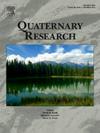Sedimentation rate changes across the Chinese Loess Plateau from luminescence dating of Malan loess in the Sanmen Gorge
IF 1.8
3区 地球科学
Q3 GEOGRAPHY, PHYSICAL
引用次数: 0
Abstract
The Chinese Loess Plateau (CLP), recognized as the world's largest loess plateau, has been a subject of ongoing debate regarding the continuity of its sedimentary loess sequence due to its intricate depositional environment. In this study, we conducted dating on a 9.8-m-long Malan loess core obtained from the Sanmen Gorge in the southern CLP using optically stimulated luminescence (OSL). The OSL dates indicate loess deposition between 52.4 and 11.3 ka, with no apparent hiatus on a millennial scale, and a sedimentation rate (SR) exhibiting six distinct episodes. Additionally, a comprehensive review of 613 OSL ages from 18 sections at 14 sites across the CLP was conducted. The results reveal loess deposition at most sites shows no apparent hiatus on a millennial scale over the past 60 ka, except for two specific locations. High SR episodes during Marine Isotope Stage (MIS) 3 across the CLP were attributed to heightened dust emissions from the source region and an enhanced dust deposition efficiency, while MIS 2 deposits were influenced by an intensified East Asian winter monsoon. Low SR episodes during MIS 1 at most sites were likely associated with reduced atmospheric transportation and pedogenesis. Spatially heterogeneous SR variations across the CLP might be influenced by local depositional environments.从三门峡马兰黄土的发光测年看中国黄土高原沉积速率的变化
中国黄土高原(CLP)是公认的世界上最大的黄土高原,由于其复杂的沉积环境,其沉积黄土序列的连续性一直是争论的焦点。在这项研究中,我们利用光激发发光法(OSL)对从中南部黄土高原三门峡获得的长 9.8 米的马兰黄土岩芯进行了测年。OSL测年结果表明,黄土沉积介于52.4-11.3ka之间,没有明显的千年尺度的间断,沉积速率(SR)表现出六个不同的阶段。此外,还对中国大陆坡 14 个地点 18 个断面的 613 个 OSL 年龄进行了全面审查。结果表明,除两个特定地点外,大多数地点的黄土沉积在过去 60 ka 年中没有出现明显的千年尺度的中断。中華電力城海洋同位素階段(MIS)3的高SR事件是由於來自源區的塵埃排放增加和塵埃沉積效率提高所致,而MIS 2的沉積則受到東亞冬季季候風加強的影響。大多数地点在MIS 1期间的低SR事件可能与大气传输和成土作用减弱有关。中南半岛各地空间上不同的SR变化可能受到当地沉积环境的影响。
本文章由计算机程序翻译,如有差异,请以英文原文为准。
求助全文
约1分钟内获得全文
求助全文
来源期刊

Quaternary Research
地学-地球科学综合
CiteScore
4.70
自引率
8.70%
发文量
57
审稿时长
3 months
期刊介绍:
Quaternary Research is an international journal devoted to the advancement of the interdisciplinary understanding of the Quaternary Period. We aim to publish articles of broad interest with relevance to more than one discipline, and that constitute a significant new contribution to Quaternary science. The journal’s scope is global, building on its nearly 50-year history in advancing the understanding of earth and human history through interdisciplinary study of the last 2.6 million years.
 求助内容:
求助内容: 应助结果提醒方式:
应助结果提醒方式:


